Analysis of Culture and Business: Leadership Management Report
VerifiedAdded on 2021/05/31
|8
|2745
|133
Report
AI Summary
This report delves into the critical intersection of culture and business, emphasizing the significance of cross-cultural management in today's globalized environment. It highlights how cultural diversity, stemming from employees' varied backgrounds and the expansion of businesses across geographical boundaries, necessitates effective strategies to mitigate conflicts and enhance productivity. The report underscores the role of global leadership in fostering a cohesive work environment, promoting effective communication, and implementing cultural training programs. It examines the impact of cultural differences on decision-making, ethical considerations, and overall business performance, providing insights into how organizations can navigate these challenges. Furthermore, the report stresses the importance of understanding cultural nuances, embracing diverse perspectives, and leveraging technology to facilitate communication and collaboration among employees. The conclusion reinforces the essential role of strong leadership in managing cultural diversity and fostering a positive, productive workplace.
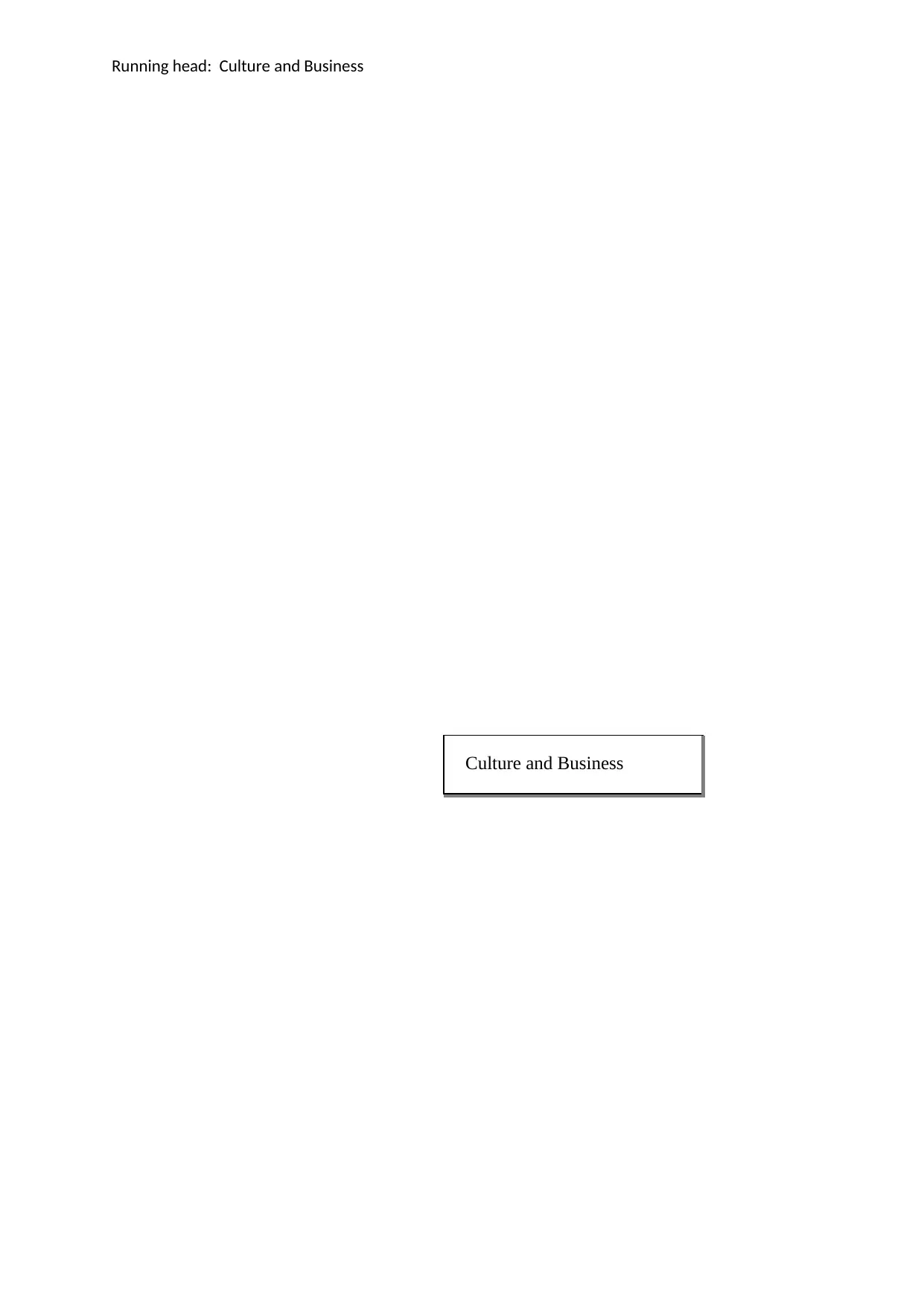
Running head: Culture and Business
Culture and Business
Culture and Business
Paraphrase This Document
Need a fresh take? Get an instant paraphrase of this document with our AI Paraphraser
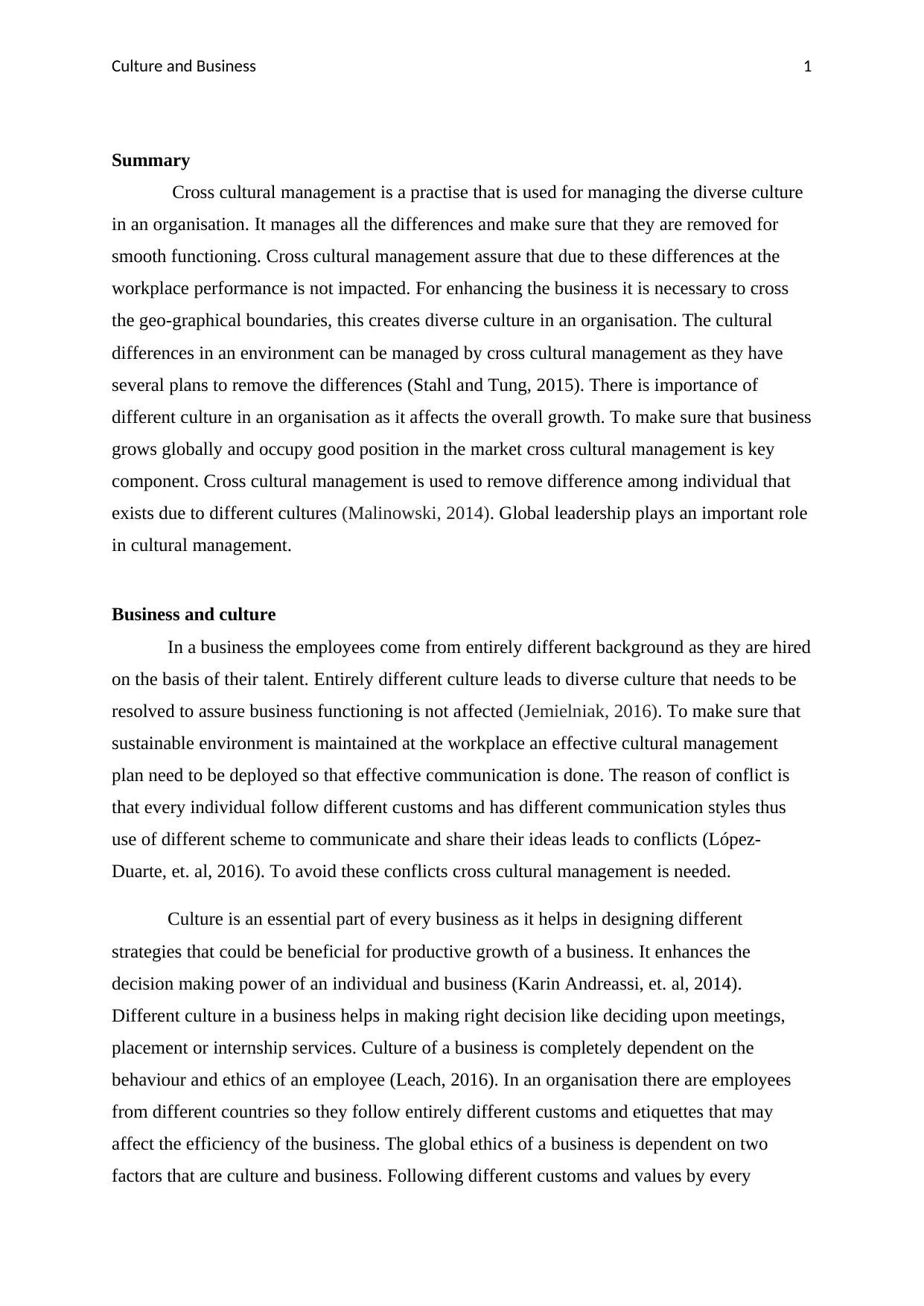
Culture and Business 1
Summary
Cross cultural management is a practise that is used for managing the diverse culture
in an organisation. It manages all the differences and make sure that they are removed for
smooth functioning. Cross cultural management assure that due to these differences at the
workplace performance is not impacted. For enhancing the business it is necessary to cross
the geo-graphical boundaries, this creates diverse culture in an organisation. The cultural
differences in an environment can be managed by cross cultural management as they have
several plans to remove the differences (Stahl and Tung, 2015). There is importance of
different culture in an organisation as it affects the overall growth. To make sure that business
grows globally and occupy good position in the market cross cultural management is key
component. Cross cultural management is used to remove difference among individual that
exists due to different cultures (Malinowski, 2014). Global leadership plays an important role
in cultural management.
Business and culture
In a business the employees come from entirely different background as they are hired
on the basis of their talent. Entirely different culture leads to diverse culture that needs to be
resolved to assure business functioning is not affected (Jemielniak, 2016). To make sure that
sustainable environment is maintained at the workplace an effective cultural management
plan need to be deployed so that effective communication is done. The reason of conflict is
that every individual follow different customs and has different communication styles thus
use of different scheme to communicate and share their ideas leads to conflicts (López-
Duarte, et. al, 2016). To avoid these conflicts cross cultural management is needed.
Culture is an essential part of every business as it helps in designing different
strategies that could be beneficial for productive growth of a business. It enhances the
decision making power of an individual and business (Karin Andreassi, et. al, 2014).
Different culture in a business helps in making right decision like deciding upon meetings,
placement or internship services. Culture of a business is completely dependent on the
behaviour and ethics of an employee (Leach, 2016). In an organisation there are employees
from different countries so they follow entirely different customs and etiquettes that may
affect the efficiency of the business. The global ethics of a business is dependent on two
factors that are culture and business. Following different customs and values by every
Summary
Cross cultural management is a practise that is used for managing the diverse culture
in an organisation. It manages all the differences and make sure that they are removed for
smooth functioning. Cross cultural management assure that due to these differences at the
workplace performance is not impacted. For enhancing the business it is necessary to cross
the geo-graphical boundaries, this creates diverse culture in an organisation. The cultural
differences in an environment can be managed by cross cultural management as they have
several plans to remove the differences (Stahl and Tung, 2015). There is importance of
different culture in an organisation as it affects the overall growth. To make sure that business
grows globally and occupy good position in the market cross cultural management is key
component. Cross cultural management is used to remove difference among individual that
exists due to different cultures (Malinowski, 2014). Global leadership plays an important role
in cultural management.
Business and culture
In a business the employees come from entirely different background as they are hired
on the basis of their talent. Entirely different culture leads to diverse culture that needs to be
resolved to assure business functioning is not affected (Jemielniak, 2016). To make sure that
sustainable environment is maintained at the workplace an effective cultural management
plan need to be deployed so that effective communication is done. The reason of conflict is
that every individual follow different customs and has different communication styles thus
use of different scheme to communicate and share their ideas leads to conflicts (López-
Duarte, et. al, 2016). To avoid these conflicts cross cultural management is needed.
Culture is an essential part of every business as it helps in designing different
strategies that could be beneficial for productive growth of a business. It enhances the
decision making power of an individual and business (Karin Andreassi, et. al, 2014).
Different culture in a business helps in making right decision like deciding upon meetings,
placement or internship services. Culture of a business is completely dependent on the
behaviour and ethics of an employee (Leach, 2016). In an organisation there are employees
from different countries so they follow entirely different customs and etiquettes that may
affect the efficiency of the business. The global ethics of a business is dependent on two
factors that are culture and business. Following different customs and values by every
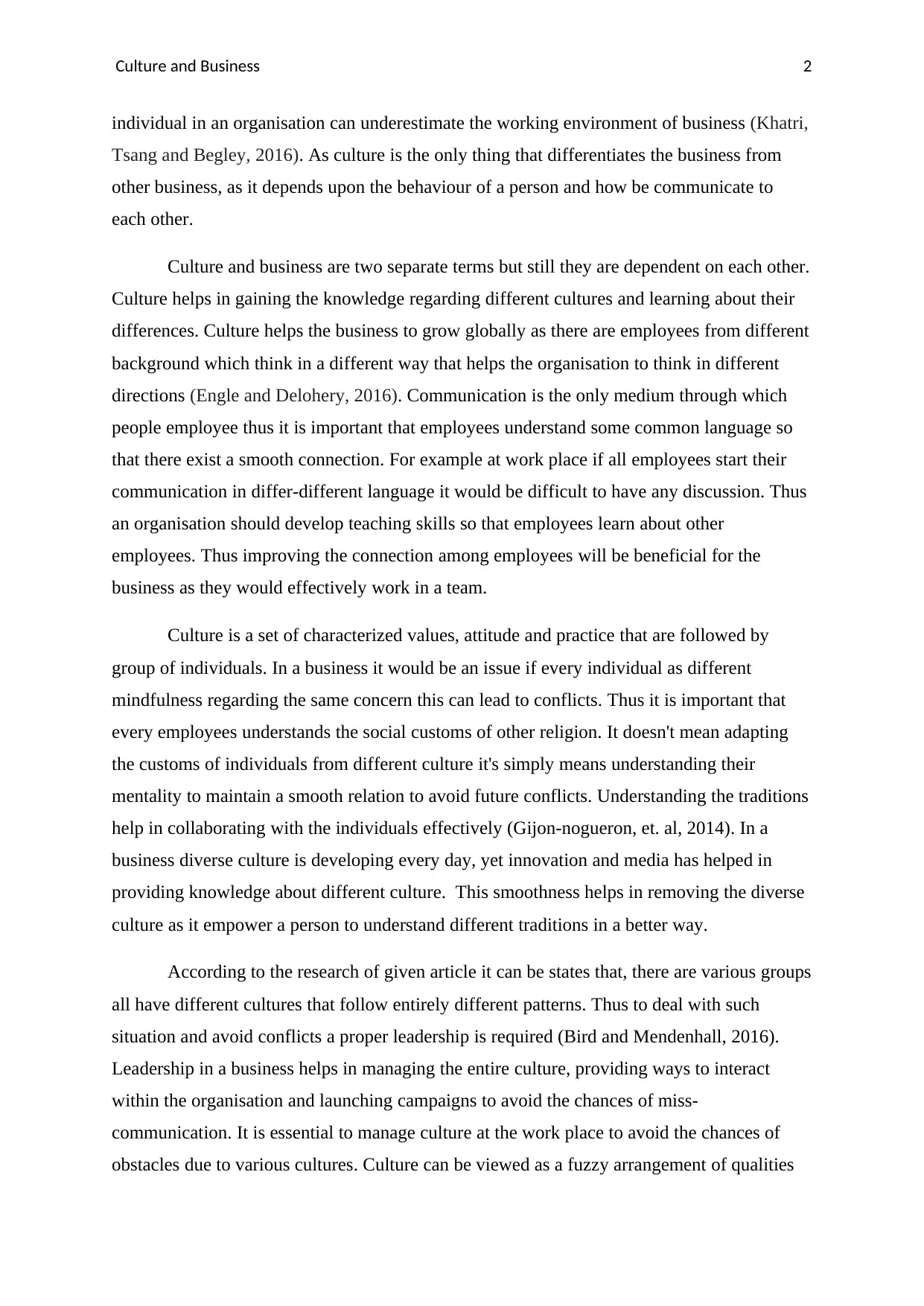
Culture and Business 2
individual in an organisation can underestimate the working environment of business (Khatri,
Tsang and Begley, 2016). As culture is the only thing that differentiates the business from
other business, as it depends upon the behaviour of a person and how be communicate to
each other.
Culture and business are two separate terms but still they are dependent on each other.
Culture helps in gaining the knowledge regarding different cultures and learning about their
differences. Culture helps the business to grow globally as there are employees from different
background which think in a different way that helps the organisation to think in different
directions (Engle and Delohery, 2016). Communication is the only medium through which
people employee thus it is important that employees understand some common language so
that there exist a smooth connection. For example at work place if all employees start their
communication in differ-different language it would be difficult to have any discussion. Thus
an organisation should develop teaching skills so that employees learn about other
employees. Thus improving the connection among employees will be beneficial for the
business as they would effectively work in a team.
Culture is a set of characterized values, attitude and practice that are followed by
group of individuals. In a business it would be an issue if every individual as different
mindfulness regarding the same concern this can lead to conflicts. Thus it is important that
every employees understands the social customs of other religion. It doesn't mean adapting
the customs of individuals from different culture it's simply means understanding their
mentality to maintain a smooth relation to avoid future conflicts. Understanding the traditions
help in collaborating with the individuals effectively (Gijon-nogueron, et. al, 2014). In a
business diverse culture is developing every day, yet innovation and media has helped in
providing knowledge about different culture. This smoothness helps in removing the diverse
culture as it empower a person to understand different traditions in a better way.
According to the research of given article it can be states that, there are various groups
all have different cultures that follow entirely different patterns. Thus to deal with such
situation and avoid conflicts a proper leadership is required (Bird and Mendenhall, 2016).
Leadership in a business helps in managing the entire culture, providing ways to interact
within the organisation and launching campaigns to avoid the chances of miss-
communication. It is essential to manage culture at the work place to avoid the chances of
obstacles due to various cultures. Culture can be viewed as a fuzzy arrangement of qualities
individual in an organisation can underestimate the working environment of business (Khatri,
Tsang and Begley, 2016). As culture is the only thing that differentiates the business from
other business, as it depends upon the behaviour of a person and how be communicate to
each other.
Culture and business are two separate terms but still they are dependent on each other.
Culture helps in gaining the knowledge regarding different cultures and learning about their
differences. Culture helps the business to grow globally as there are employees from different
background which think in a different way that helps the organisation to think in different
directions (Engle and Delohery, 2016). Communication is the only medium through which
people employee thus it is important that employees understand some common language so
that there exist a smooth connection. For example at work place if all employees start their
communication in differ-different language it would be difficult to have any discussion. Thus
an organisation should develop teaching skills so that employees learn about other
employees. Thus improving the connection among employees will be beneficial for the
business as they would effectively work in a team.
Culture is a set of characterized values, attitude and practice that are followed by
group of individuals. In a business it would be an issue if every individual as different
mindfulness regarding the same concern this can lead to conflicts. Thus it is important that
every employees understands the social customs of other religion. It doesn't mean adapting
the customs of individuals from different culture it's simply means understanding their
mentality to maintain a smooth relation to avoid future conflicts. Understanding the traditions
help in collaborating with the individuals effectively (Gijon-nogueron, et. al, 2014). In a
business diverse culture is developing every day, yet innovation and media has helped in
providing knowledge about different culture. This smoothness helps in removing the diverse
culture as it empower a person to understand different traditions in a better way.
According to the research of given article it can be states that, there are various groups
all have different cultures that follow entirely different patterns. Thus to deal with such
situation and avoid conflicts a proper leadership is required (Bird and Mendenhall, 2016).
Leadership in a business helps in managing the entire culture, providing ways to interact
within the organisation and launching campaigns to avoid the chances of miss-
communication. It is essential to manage culture at the work place to avoid the chances of
obstacles due to various cultures. Culture can be viewed as a fuzzy arrangement of qualities
⊘ This is a preview!⊘
Do you want full access?
Subscribe today to unlock all pages.

Trusted by 1+ million students worldwide
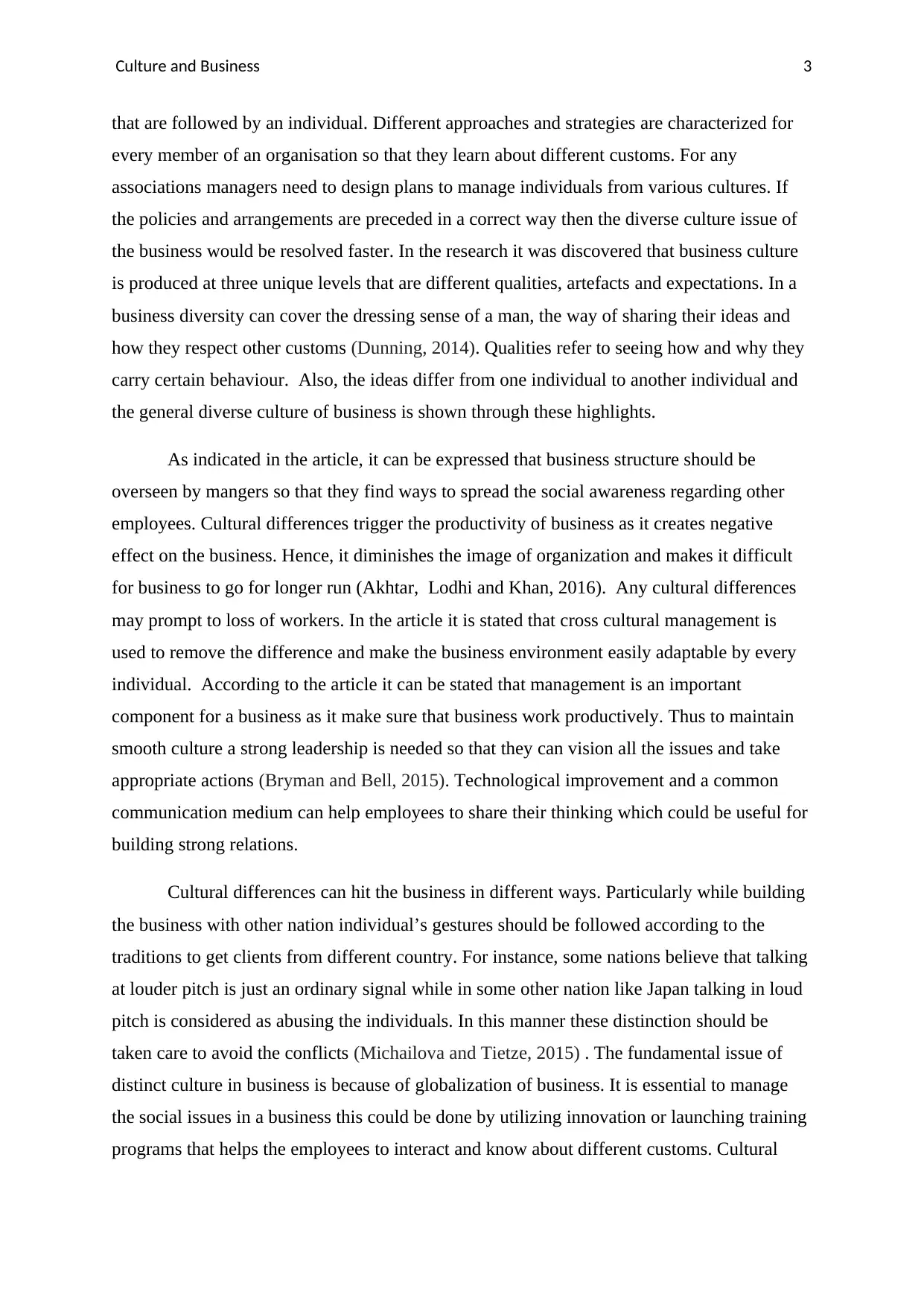
Culture and Business 3
that are followed by an individual. Different approaches and strategies are characterized for
every member of an organisation so that they learn about different customs. For any
associations managers need to design plans to manage individuals from various cultures. If
the policies and arrangements are preceded in a correct way then the diverse culture issue of
the business would be resolved faster. In the research it was discovered that business culture
is produced at three unique levels that are different qualities, artefacts and expectations. In a
business diversity can cover the dressing sense of a man, the way of sharing their ideas and
how they respect other customs (Dunning, 2014). Qualities refer to seeing how and why they
carry certain behaviour. Also, the ideas differ from one individual to another individual and
the general diverse culture of business is shown through these highlights.
As indicated in the article, it can be expressed that business structure should be
overseen by mangers so that they find ways to spread the social awareness regarding other
employees. Cultural differences trigger the productivity of business as it creates negative
effect on the business. Hence, it diminishes the image of organization and makes it difficult
for business to go for longer run (Akhtar, Lodhi and Khan, 2016). Any cultural differences
may prompt to loss of workers. In the article it is stated that cross cultural management is
used to remove the difference and make the business environment easily adaptable by every
individual. According to the article it can be stated that management is an important
component for a business as it make sure that business work productively. Thus to maintain
smooth culture a strong leadership is needed so that they can vision all the issues and take
appropriate actions (Bryman and Bell, 2015). Technological improvement and a common
communication medium can help employees to share their thinking which could be useful for
building strong relations.
Cultural differences can hit the business in different ways. Particularly while building
the business with other nation individual’s gestures should be followed according to the
traditions to get clients from different country. For instance, some nations believe that talking
at louder pitch is just an ordinary signal while in some other nation like Japan talking in loud
pitch is considered as abusing the individuals. In this manner these distinction should be
taken care to avoid the conflicts (Michailova and Tietze, 2015) . The fundamental issue of
distinct culture in business is because of globalization of business. It is essential to manage
the social issues in a business this could be done by utilizing innovation or launching training
programs that helps the employees to interact and know about different customs. Cultural
that are followed by an individual. Different approaches and strategies are characterized for
every member of an organisation so that they learn about different customs. For any
associations managers need to design plans to manage individuals from various cultures. If
the policies and arrangements are preceded in a correct way then the diverse culture issue of
the business would be resolved faster. In the research it was discovered that business culture
is produced at three unique levels that are different qualities, artefacts and expectations. In a
business diversity can cover the dressing sense of a man, the way of sharing their ideas and
how they respect other customs (Dunning, 2014). Qualities refer to seeing how and why they
carry certain behaviour. Also, the ideas differ from one individual to another individual and
the general diverse culture of business is shown through these highlights.
As indicated in the article, it can be expressed that business structure should be
overseen by mangers so that they find ways to spread the social awareness regarding other
employees. Cultural differences trigger the productivity of business as it creates negative
effect on the business. Hence, it diminishes the image of organization and makes it difficult
for business to go for longer run (Akhtar, Lodhi and Khan, 2016). Any cultural differences
may prompt to loss of workers. In the article it is stated that cross cultural management is
used to remove the difference and make the business environment easily adaptable by every
individual. According to the article it can be stated that management is an important
component for a business as it make sure that business work productively. Thus to maintain
smooth culture a strong leadership is needed so that they can vision all the issues and take
appropriate actions (Bryman and Bell, 2015). Technological improvement and a common
communication medium can help employees to share their thinking which could be useful for
building strong relations.
Cultural differences can hit the business in different ways. Particularly while building
the business with other nation individual’s gestures should be followed according to the
traditions to get clients from different country. For instance, some nations believe that talking
at louder pitch is just an ordinary signal while in some other nation like Japan talking in loud
pitch is considered as abusing the individuals. In this manner these distinction should be
taken care to avoid the conflicts (Michailova and Tietze, 2015) . The fundamental issue of
distinct culture in business is because of globalization of business. It is essential to manage
the social issues in a business this could be done by utilizing innovation or launching training
programs that helps the employees to interact and know about different customs. Cultural
Paraphrase This Document
Need a fresh take? Get an instant paraphrase of this document with our AI Paraphraser
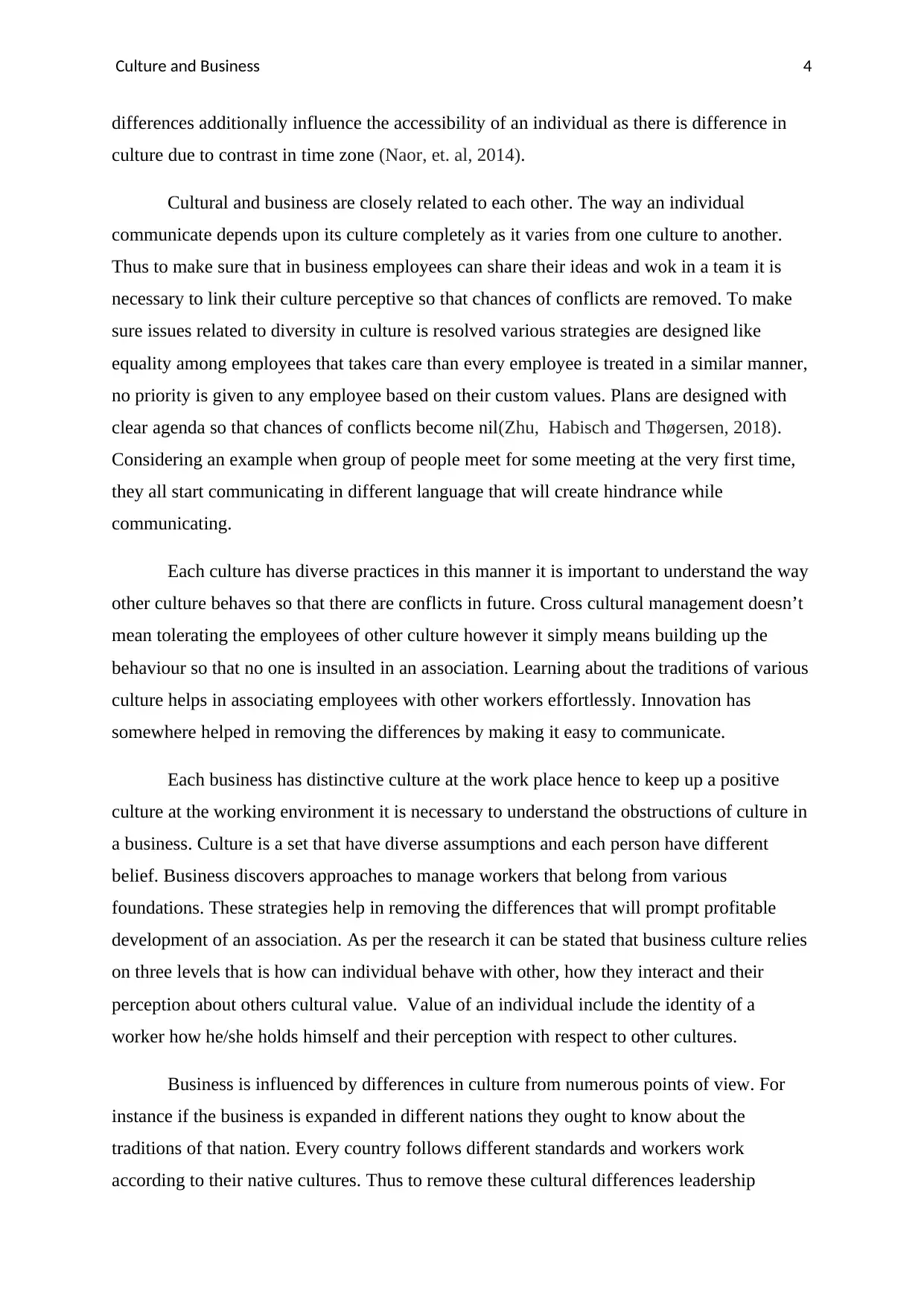
Culture and Business 4
differences additionally influence the accessibility of an individual as there is difference in
culture due to contrast in time zone (Naor, et. al, 2014).
Cultural and business are closely related to each other. The way an individual
communicate depends upon its culture completely as it varies from one culture to another.
Thus to make sure that in business employees can share their ideas and wok in a team it is
necessary to link their culture perceptive so that chances of conflicts are removed. To make
sure issues related to diversity in culture is resolved various strategies are designed like
equality among employees that takes care than every employee is treated in a similar manner,
no priority is given to any employee based on their custom values. Plans are designed with
clear agenda so that chances of conflicts become nil(Zhu, Habisch and Thøgersen, 2018).
Considering an example when group of people meet for some meeting at the very first time,
they all start communicating in different language that will create hindrance while
communicating.
Each culture has diverse practices in this manner it is important to understand the way
other culture behaves so that there are conflicts in future. Cross cultural management doesn’t
mean tolerating the employees of other culture however it simply means building up the
behaviour so that no one is insulted in an association. Learning about the traditions of various
culture helps in associating employees with other workers effortlessly. Innovation has
somewhere helped in removing the differences by making it easy to communicate.
Each business has distinctive culture at the work place hence to keep up a positive
culture at the working environment it is necessary to understand the obstructions of culture in
a business. Culture is a set that have diverse assumptions and each person have different
belief. Business discovers approaches to manage workers that belong from various
foundations. These strategies help in removing the differences that will prompt profitable
development of an association. As per the research it can be stated that business culture relies
on three levels that is how can individual behave with other, how they interact and their
perception about others cultural value. Value of an individual include the identity of a
worker how he/she holds himself and their perception with respect to other cultures.
Business is influenced by differences in culture from numerous points of view. For
instance if the business is expanded in different nations they ought to know about the
traditions of that nation. Every country follows different standards and workers work
according to their native cultures. Thus to remove these cultural differences leadership
differences additionally influence the accessibility of an individual as there is difference in
culture due to contrast in time zone (Naor, et. al, 2014).
Cultural and business are closely related to each other. The way an individual
communicate depends upon its culture completely as it varies from one culture to another.
Thus to make sure that in business employees can share their ideas and wok in a team it is
necessary to link their culture perceptive so that chances of conflicts are removed. To make
sure issues related to diversity in culture is resolved various strategies are designed like
equality among employees that takes care than every employee is treated in a similar manner,
no priority is given to any employee based on their custom values. Plans are designed with
clear agenda so that chances of conflicts become nil(Zhu, Habisch and Thøgersen, 2018).
Considering an example when group of people meet for some meeting at the very first time,
they all start communicating in different language that will create hindrance while
communicating.
Each culture has diverse practices in this manner it is important to understand the way
other culture behaves so that there are conflicts in future. Cross cultural management doesn’t
mean tolerating the employees of other culture however it simply means building up the
behaviour so that no one is insulted in an association. Learning about the traditions of various
culture helps in associating employees with other workers effortlessly. Innovation has
somewhere helped in removing the differences by making it easy to communicate.
Each business has distinctive culture at the work place hence to keep up a positive
culture at the working environment it is necessary to understand the obstructions of culture in
a business. Culture is a set that have diverse assumptions and each person have different
belief. Business discovers approaches to manage workers that belong from various
foundations. These strategies help in removing the differences that will prompt profitable
development of an association. As per the research it can be stated that business culture relies
on three levels that is how can individual behave with other, how they interact and their
perception about others cultural value. Value of an individual include the identity of a
worker how he/she holds himself and their perception with respect to other cultures.
Business is influenced by differences in culture from numerous points of view. For
instance if the business is expanded in different nations they ought to know about the
traditions of that nation. Every country follows different standards and workers work
according to their native cultures. Thus to remove these cultural differences leadership
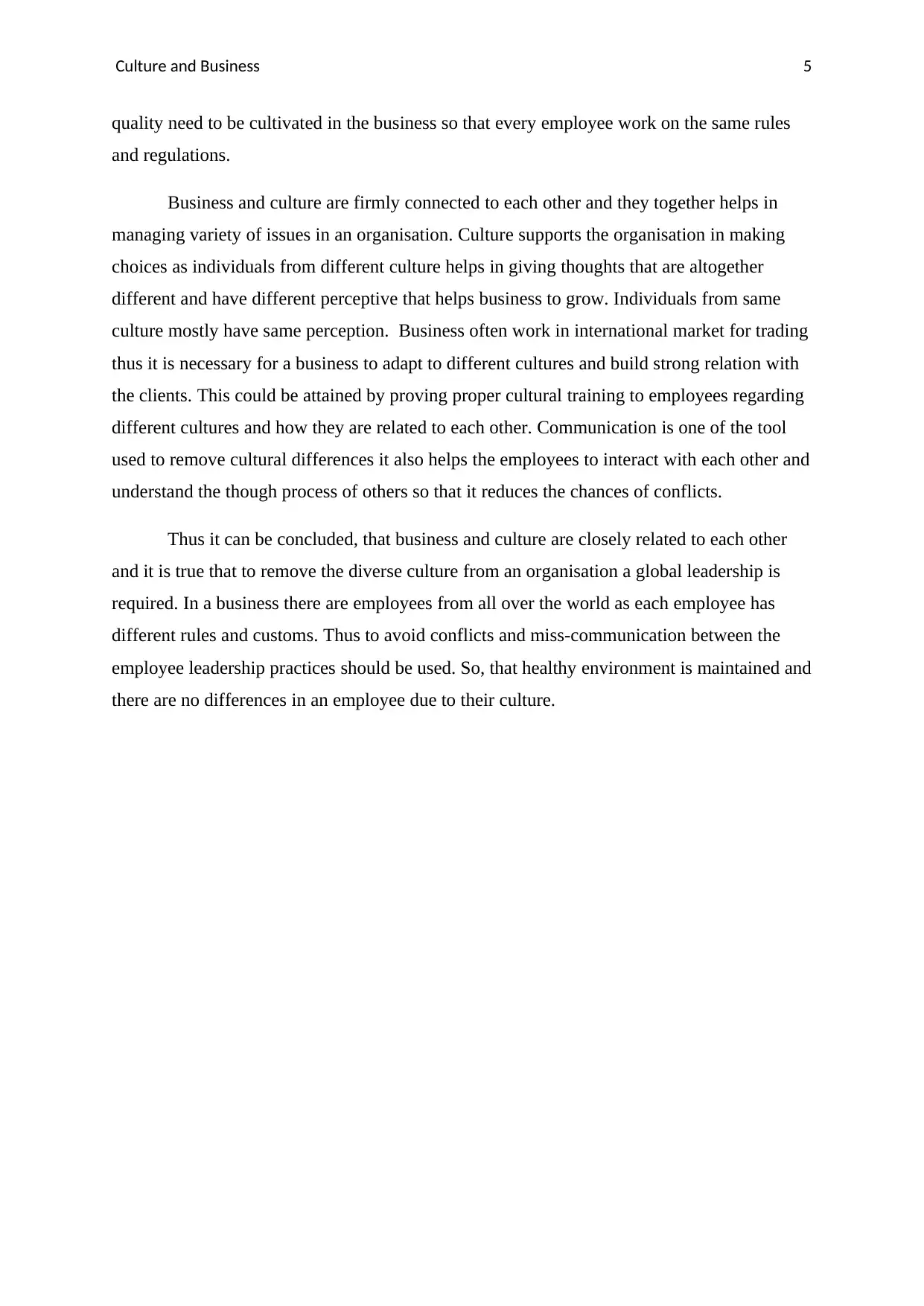
Culture and Business 5
quality need to be cultivated in the business so that every employee work on the same rules
and regulations.
Business and culture are firmly connected to each other and they together helps in
managing variety of issues in an organisation. Culture supports the organisation in making
choices as individuals from different culture helps in giving thoughts that are altogether
different and have different perceptive that helps business to grow. Individuals from same
culture mostly have same perception. Business often work in international market for trading
thus it is necessary for a business to adapt to different cultures and build strong relation with
the clients. This could be attained by proving proper cultural training to employees regarding
different cultures and how they are related to each other. Communication is one of the tool
used to remove cultural differences it also helps the employees to interact with each other and
understand the though process of others so that it reduces the chances of conflicts.
Thus it can be concluded, that business and culture are closely related to each other
and it is true that to remove the diverse culture from an organisation a global leadership is
required. In a business there are employees from all over the world as each employee has
different rules and customs. Thus to avoid conflicts and miss-communication between the
employee leadership practices should be used. So, that healthy environment is maintained and
there are no differences in an employee due to their culture.
quality need to be cultivated in the business so that every employee work on the same rules
and regulations.
Business and culture are firmly connected to each other and they together helps in
managing variety of issues in an organisation. Culture supports the organisation in making
choices as individuals from different culture helps in giving thoughts that are altogether
different and have different perceptive that helps business to grow. Individuals from same
culture mostly have same perception. Business often work in international market for trading
thus it is necessary for a business to adapt to different cultures and build strong relation with
the clients. This could be attained by proving proper cultural training to employees regarding
different cultures and how they are related to each other. Communication is one of the tool
used to remove cultural differences it also helps the employees to interact with each other and
understand the though process of others so that it reduces the chances of conflicts.
Thus it can be concluded, that business and culture are closely related to each other
and it is true that to remove the diverse culture from an organisation a global leadership is
required. In a business there are employees from all over the world as each employee has
different rules and customs. Thus to avoid conflicts and miss-communication between the
employee leadership practices should be used. So, that healthy environment is maintained and
there are no differences in an employee due to their culture.
⊘ This is a preview!⊘
Do you want full access?
Subscribe today to unlock all pages.

Trusted by 1+ million students worldwide
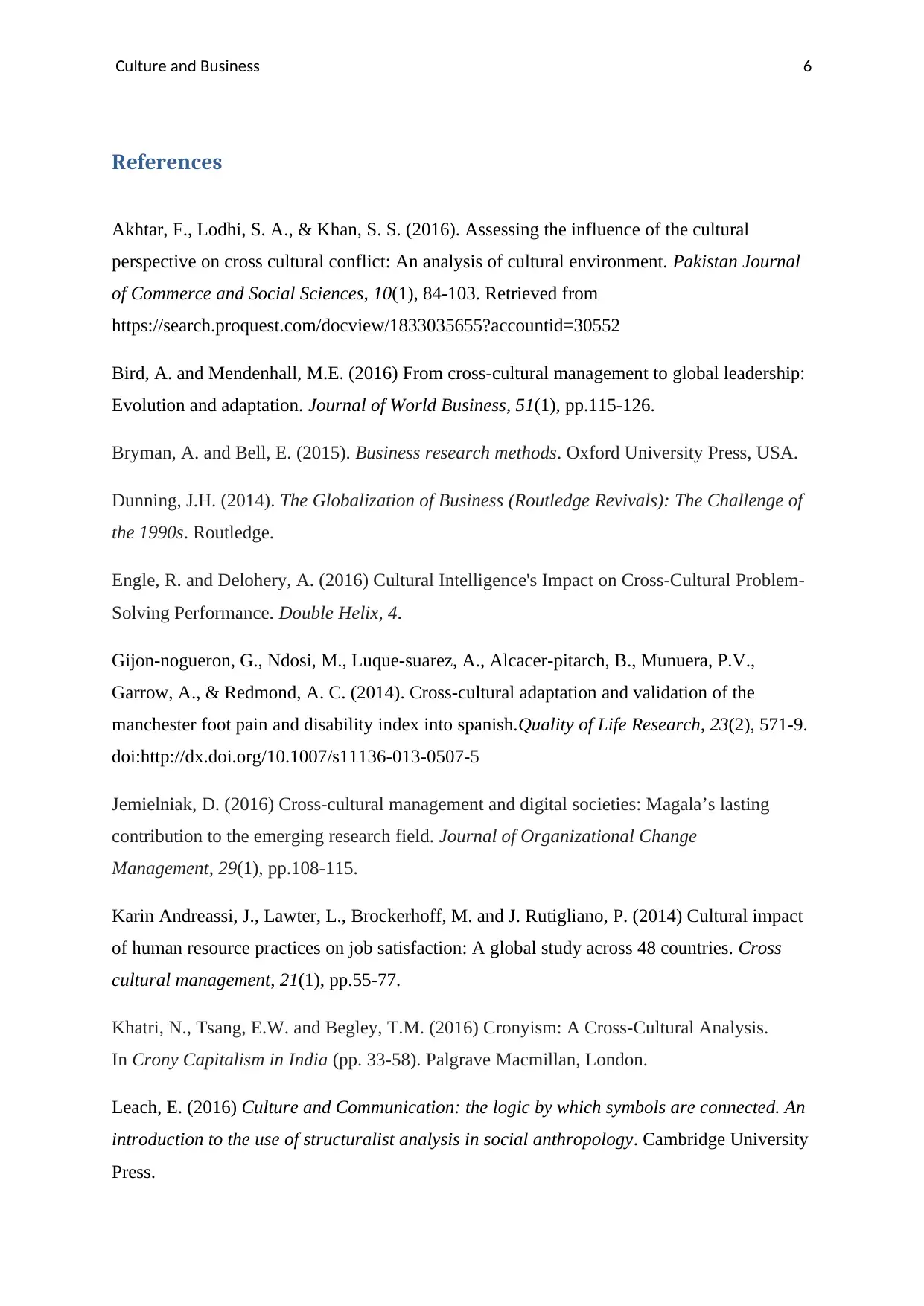
Culture and Business 6
References
Akhtar, F., Lodhi, S. A., & Khan, S. S. (2016). Assessing the influence of the cultural
perspective on cross cultural conflict: An analysis of cultural environment. Pakistan Journal
of Commerce and Social Sciences, 10(1), 84-103. Retrieved from
https://search.proquest.com/docview/1833035655?accountid=30552
Bird, A. and Mendenhall, M.E. (2016) From cross-cultural management to global leadership:
Evolution and adaptation. Journal of World Business, 51(1), pp.115-126.
Bryman, A. and Bell, E. (2015). Business research methods. Oxford University Press, USA.
Dunning, J.H. (2014). The Globalization of Business (Routledge Revivals): The Challenge of
the 1990s. Routledge.
Engle, R. and Delohery, A. (2016) Cultural Intelligence's Impact on Cross-Cultural Problem-
Solving Performance. Double Helix, 4.
Gijon-nogueron, G., Ndosi, M., Luque-suarez, A., Alcacer-pitarch, B., Munuera, P.V.,
Garrow, A., & Redmond, A. C. (2014). Cross-cultural adaptation and validation of the
manchester foot pain and disability index into spanish.Quality of Life Research, 23(2), 571-9.
doi:http://dx.doi.org/10.1007/s11136-013-0507-5
Jemielniak, D. (2016) Cross-cultural management and digital societies: Magala’s lasting
contribution to the emerging research field. Journal of Organizational Change
Management, 29(1), pp.108-115.
Karin Andreassi, J., Lawter, L., Brockerhoff, M. and J. Rutigliano, P. (2014) Cultural impact
of human resource practices on job satisfaction: A global study across 48 countries. Cross
cultural management, 21(1), pp.55-77.
Khatri, N., Tsang, E.W. and Begley, T.M. (2016) Cronyism: A Cross-Cultural Analysis.
In Crony Capitalism in India (pp. 33-58). Palgrave Macmillan, London.
Leach, E. (2016) Culture and Communication: the logic by which symbols are connected. An
introduction to the use of structuralist analysis in social anthropology. Cambridge University
Press.
References
Akhtar, F., Lodhi, S. A., & Khan, S. S. (2016). Assessing the influence of the cultural
perspective on cross cultural conflict: An analysis of cultural environment. Pakistan Journal
of Commerce and Social Sciences, 10(1), 84-103. Retrieved from
https://search.proquest.com/docview/1833035655?accountid=30552
Bird, A. and Mendenhall, M.E. (2016) From cross-cultural management to global leadership:
Evolution and adaptation. Journal of World Business, 51(1), pp.115-126.
Bryman, A. and Bell, E. (2015). Business research methods. Oxford University Press, USA.
Dunning, J.H. (2014). The Globalization of Business (Routledge Revivals): The Challenge of
the 1990s. Routledge.
Engle, R. and Delohery, A. (2016) Cultural Intelligence's Impact on Cross-Cultural Problem-
Solving Performance. Double Helix, 4.
Gijon-nogueron, G., Ndosi, M., Luque-suarez, A., Alcacer-pitarch, B., Munuera, P.V.,
Garrow, A., & Redmond, A. C. (2014). Cross-cultural adaptation and validation of the
manchester foot pain and disability index into spanish.Quality of Life Research, 23(2), 571-9.
doi:http://dx.doi.org/10.1007/s11136-013-0507-5
Jemielniak, D. (2016) Cross-cultural management and digital societies: Magala’s lasting
contribution to the emerging research field. Journal of Organizational Change
Management, 29(1), pp.108-115.
Karin Andreassi, J., Lawter, L., Brockerhoff, M. and J. Rutigliano, P. (2014) Cultural impact
of human resource practices on job satisfaction: A global study across 48 countries. Cross
cultural management, 21(1), pp.55-77.
Khatri, N., Tsang, E.W. and Begley, T.M. (2016) Cronyism: A Cross-Cultural Analysis.
In Crony Capitalism in India (pp. 33-58). Palgrave Macmillan, London.
Leach, E. (2016) Culture and Communication: the logic by which symbols are connected. An
introduction to the use of structuralist analysis in social anthropology. Cambridge University
Press.
Paraphrase This Document
Need a fresh take? Get an instant paraphrase of this document with our AI Paraphraser
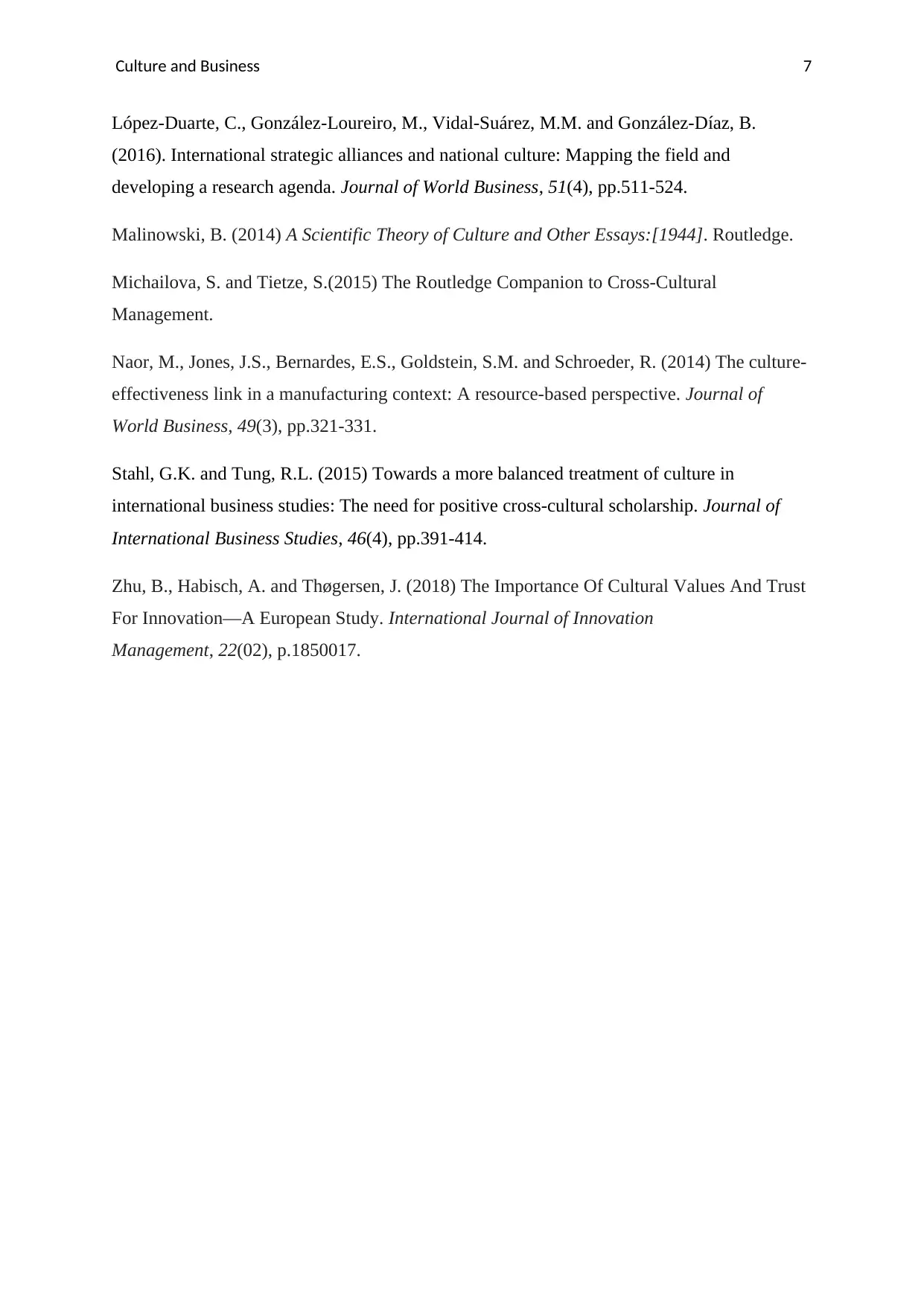
Culture and Business 7
López-Duarte, C., González-Loureiro, M., Vidal-Suárez, M.M. and González-Díaz, B.
(2016). International strategic alliances and national culture: Mapping the field and
developing a research agenda. Journal of World Business, 51(4), pp.511-524.
Malinowski, B. (2014) A Scientific Theory of Culture and Other Essays:[1944]. Routledge.
Michailova, S. and Tietze, S.(2015) The Routledge Companion to Cross-Cultural
Management.
Naor, M., Jones, J.S., Bernardes, E.S., Goldstein, S.M. and Schroeder, R. (2014) The culture-
effectiveness link in a manufacturing context: A resource-based perspective. Journal of
World Business, 49(3), pp.321-331.
Stahl, G.K. and Tung, R.L. (2015) Towards a more balanced treatment of culture in
international business studies: The need for positive cross-cultural scholarship. Journal of
International Business Studies, 46(4), pp.391-414.
Zhu, B., Habisch, A. and Thøgersen, J. (2018) The Importance Of Cultural Values And Trust
For Innovation—A European Study. International Journal of Innovation
Management, 22(02), p.1850017.
López-Duarte, C., González-Loureiro, M., Vidal-Suárez, M.M. and González-Díaz, B.
(2016). International strategic alliances and national culture: Mapping the field and
developing a research agenda. Journal of World Business, 51(4), pp.511-524.
Malinowski, B. (2014) A Scientific Theory of Culture and Other Essays:[1944]. Routledge.
Michailova, S. and Tietze, S.(2015) The Routledge Companion to Cross-Cultural
Management.
Naor, M., Jones, J.S., Bernardes, E.S., Goldstein, S.M. and Schroeder, R. (2014) The culture-
effectiveness link in a manufacturing context: A resource-based perspective. Journal of
World Business, 49(3), pp.321-331.
Stahl, G.K. and Tung, R.L. (2015) Towards a more balanced treatment of culture in
international business studies: The need for positive cross-cultural scholarship. Journal of
International Business Studies, 46(4), pp.391-414.
Zhu, B., Habisch, A. and Thøgersen, J. (2018) The Importance Of Cultural Values And Trust
For Innovation—A European Study. International Journal of Innovation
Management, 22(02), p.1850017.
1 out of 8
Related Documents
Your All-in-One AI-Powered Toolkit for Academic Success.
+13062052269
info@desklib.com
Available 24*7 on WhatsApp / Email
![[object Object]](/_next/static/media/star-bottom.7253800d.svg)
Unlock your academic potential
Copyright © 2020–2025 A2Z Services. All Rights Reserved. Developed and managed by ZUCOL.



